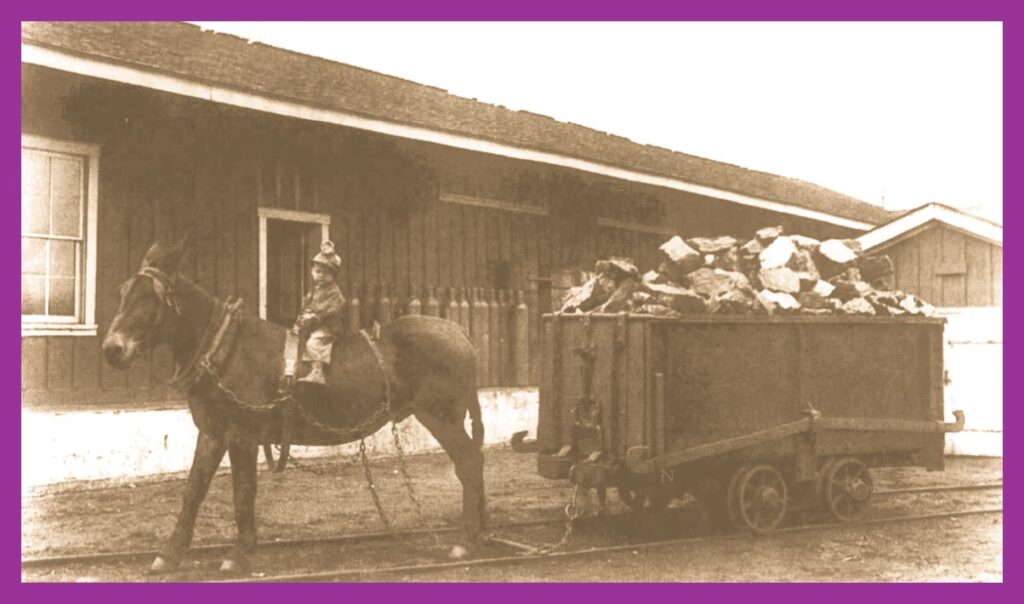Joseph Prosper is pictured on a mule about to haul a sample load of coal to be tested at Maple Hill Colliery in May 1931.
From a series of articles that appeared in the Pottsville Republican and Herald in 1998:
The North Ashland, formerly Union, Colliery was located northeast of Ashland on the Big Mine Run Creek. The colliery was opened by a drift driven east on the North Dip Mammoth Vein by John Anderson, J. W. Ryan & Company who were granted a lease from the Girard Estate in 1863. The first shipment of 15,388 tons was made in 1864.
Anderson, Ryan & Company operated the mine under the name of Union Colliery and mined the drift gangway to 1873, when it reached the limit of the lease at the Girard Mammoth Colliery barrier pillar, 8,600 feet from the mouth of the drift. During the same time it opened several drifts on the North Dip Buck Mountain Vein.
In 1874, the company drove a tunnel 360 feet north to the Buck Mountain, a point on the Mammoth Drift gangway 1,800 feet from its mouth. During the same year, a slope was sunk 330 feet on the North Dip Mammoth Vein near the center of the basin and gangways were driven east and west, which were mined to 1876.
On August 22, 1876, the colliery was leased to the Philadelphia & Reading Coal & Iron Company, which at that time changed the name to North Ashland Colliery. The company made extensive improvements in the hoisting and preparation of the coal.
In 1881, it had driven the slope gangways to the limit of the lease, eastward to the barrier pillar of Girard Mammoth Colliery and westward to a 120-foot pillar established along the eastern land line of the Girard Estate as a protection to colliery from a large body of water standing in Centralia and Haze Dale Colliery workings.
In 1884, the Philadelphia & Reading Coal & Iron Company opened the Buck Mountain Vein by a tunnel 351 feet north from the slope level.
In 1885, a fire was discovered on Sunday, June 21. In the air hole extending from the second level to the surface, water was poured into the colliery to extinguish the fire and it was removed in March 1886. Damage to the mine was extensive and the upper part of the slope was retimbered and the grade of the track changed to admit gunboats in place of the wagons formerly used.
In 1887, a large block of coal was obtained from the Mammoth Vein, dressed down and mounted on a platform, inscribed as from the Girard Estate lands and contributed by the directors of City Trusts of Philadelphia. It was sent to the American exhibition in London as part of an exhibit of the state of Pennsylvania. The block contained 22.5 cubic feet and weighed 2,256 pounds.
In 1889, the breaker was destroyed by fire on January 31 and was rebuilt by July 9 of the same year.
In January 1890, the company began sinking a new slope located near the entrance of the old water-level drift. By October, it had been timbered and double track extended from the surface to the first level, a distance of 760 feet. By March 1891, it was completed to the bottom level, 1,100 feet from the surface.
In 1892, the old hoisting engine was replaced by a large and more powerful engine.
In 1898, the North Ashland Colliery was merged with the Continental Colliery and the Philadelphia & Reading Coal and Iron Company removed the breaker machinery, steam and column pipes and abandoned the colliery.
The total shipment from North Ashland Colliery was 2,941,051 tons.
_______________________________________________
Article by Frank Blase, Historian, Reading Anthracite Company Historical Library, Pottsville Republican & Herald, January 17, 1998. Obtained from Newspapers.com.
Corrections and additional information should be added as comments to this post.
